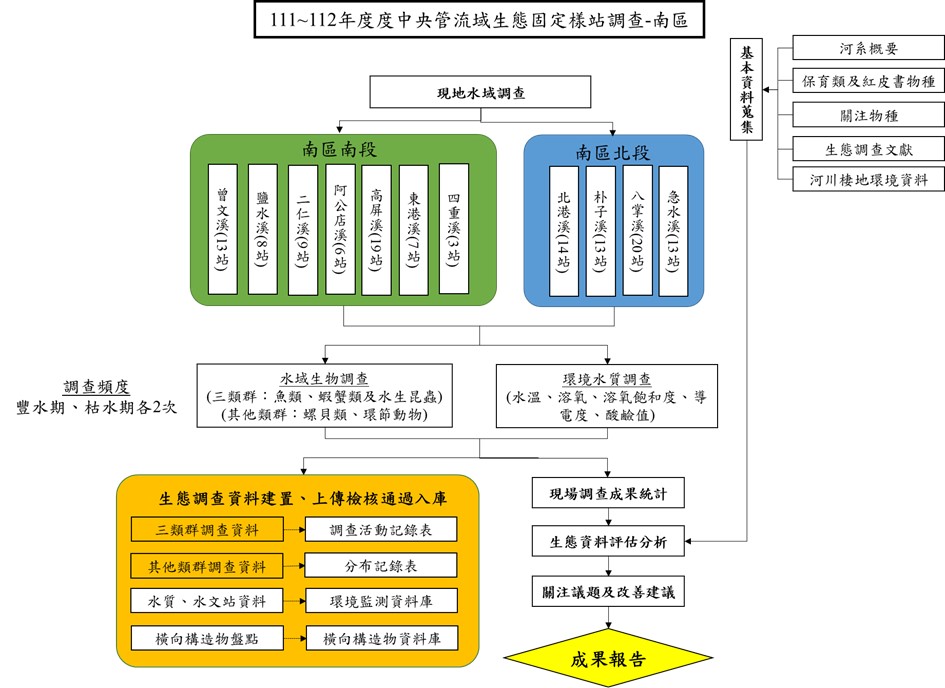I. Evolution and Framework
- Origins (since 2002): Drawing on Japan’s Basic Environmental Data and the River & Waterside National Census, Taiwan completed the Technical Specifications for Stream Status Investigation (2002) and the Guidelines for Stream Status Investigation (Draft) (2004). In 2015, the WRA promulgated the Guidelines for Stream Status Investigation, covering nine categories of aquatic and terrestrial biota.
- Data accumulation (2002–2022): Records have been uploaded to GBIF/TaiBIF, with an expected total exceeding 200,000 records.
- Institutionalization (2021–2023): Under the Operational Directions for Implementing the Integrated Improvement and Adaptation Plan for Central-Government-Administered River Basins (circular dated 2021-07-16), ecological surveys are split into fixed-station surveys (every 3 years, led by the Planning Branch) and special-project surveys. On 2022-06-15, the WRA issued the Operating Guidelines for Ecological Surveys, focusing on fishes, shrimps/crabs, and aquatic insects, collecting abundance, body length, life-history, and reproductive status data. In 2022–2023, 250 fixed stations across north, central, east, and south regions were surveyed for baseline data and field checks. Workflow (see Fig. 1).
II. Methods and Operations
- Core methods: Electrofishing, shrimp-trap method, fixed-area sampling.
- Supplementary (habitat-dependent) methods: Fish traps, cast nets, direct observation.
III. Survey Coverage and Results (2022–2023)
- North / Central / East: 15 river systems, 125 stations
- Fishes: 10 orders, 35 families, 128 species, 15,062 individuals
- Shrimps: 1 order, 5 families, 27 species, 3,300 individual records
- Crabs: 1 order, 6 families, 12 species, 66 individual records
- Aquatic insects: 7 orders, 42 families, 148 species, 6,795 individual records
- South: 11 river systems, 125 stations
- Fishes: 12 orders, 40 families, 137 species, 15,671 individuals
- Shrimps: 1 order, 5 families, 32 species, 5,484 individual records
- Crabs: 1 order, 7 families, 24 species, 314 individual records
- Mollusks (snails & bivalves): 7 orders, 17 families, 26 species, 218 individuals
- Aquatic insects: 9 orders, 63 families, 242 species, 8,895 individual records
IV. Conservation and Endemics — Highlights
- North / Central / East — conservation-listed fishes (4 taxa):
- Xiuguluan River (East): 臺東間爬岩鰍 (listed as Precious and Rare Wildlife)
- Houlong River (Central): 飯島氏銀鮈 (listed as Endangered Wildlife)
- Wu River & Zhuoshui River (Central): 陳氏鰍鮀 (listed as Precious and Rare Wildlife), 埔里中華爬岩鰍 (listed as Other Wildlife Requiring Conservation)
- South:
- Endemics recorded: fishes 23 spp., shrimps/crabs 4 spp., aquatic insects 18 spp.
- Conservation-listed fishes (3 taxa):
- Beigang River: 陳氏鰍鮀 (Precious and Rare Wildlife)
- Zengwen River & Qishan River (Gaoping tributary): 南臺中華爬岩鰍 (Other Wildlife Requiring Conservation)
- Qishan River (Gaoping basin): 中間鰍鮀 (Other Wildlife Requiring Conservation)
V. Value and Applications
- A triennial fixed-station framework ensures comparable long-term time-series data.
- GBIF/TaiBIF open data enhance transparency in biodiversity information.
- Outputs support trend assessment, conservation zoning adjustments, and eco-friendly design in water resources engineering.

Fig. 1 Fixed-station ecological survey workflow for central-government-administered rivers—Southern Region example.